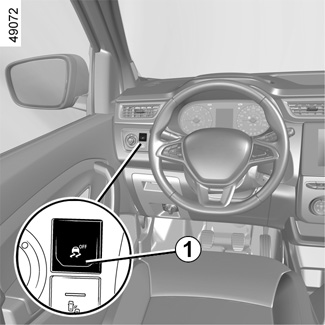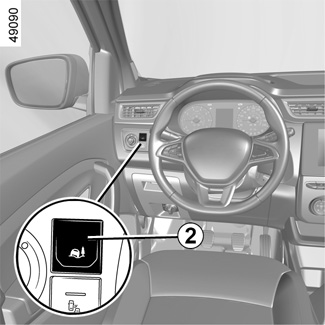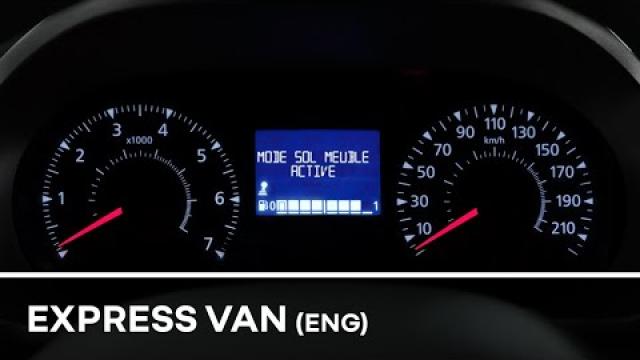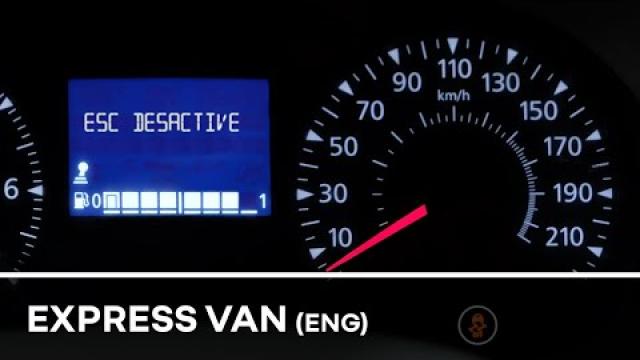DRIVER CORRECTION DEVICES, AIDS
Depending on the vehicle, this is composed of:
- anti-lock braking system (ABS);
- electronic stability program (ESC) with understeer control and traction control;
- emergency brake assist;
- hill start assist;
- driver assistance with a trailer;
- of the traction control - Extended grip.
Anti-lock braking system (ABS)
Under heavy braking, the ABS prevents the wheels from locking, allowing the stopping distance to be managed and keeping control of the vehicle.
Under these circumstances, the vehicle can be steered to avoid an obstacle whilst braking. In addition, this system can increase stopping distances, particularly on roads with low surface grip (wet ground, etc.).
You will feel a pulsation through the brake pedal each time the system is activated. The ABS does not in any way improve the vehicle’s physical performance relating to the road surface and road-holding. It is still essential to follow the rules of good driving practice (such as driving at a safe distance from the vehicle in front, etc.).
Operating faults:
- © and x lit up on the instrument panel accompanied by the messages “CHECK ABS”, “CHECK BRAKING SYSTEM” and “Check ESC”: this indicates that the ABS, the ESC and the emergency brake assist are disabled. Braking is always enabled;
- x, D, © and ® lit up on the instrument panel alongside the message “Braking system fault”: this indicates a fault in the braking system.
In both cases, please consult an Authorised Dealer.
In an emergency, apply firm and continuous pressure to the brake pedal. There is no need to pump it repeatedly. The ABS will modulate the force applied in the braking system.
Your braking systems are partially operational. However, it is dangerous to brake suddenly and it is essential to stop immediately, as soon as traffic conditions allow. Contact an approved dealer.
Electronic stability control (ESC) with understeer control and traction control
Electronic stability control ESC
This system helps you to keep control of the vehicle in critical driving conditions (avoiding an obstacle, loss of grip on a bend, etc.).
Operating principle
A sensor in the steering wheel detects the direction selected by the driver.
Other sensors throughout the vehicle measure the actual direction.
The system compares driver input to the actual trajectory of the vehicle and corrects the trajectory if necessary by controlling the braking of certain wheels and/or engine power. In the event that the system is engaged, indicator light flashes on the instrument panel.
Understeer control
This system optimises the action of the ESC in the case of pronounced understeering (loss of front axle road holding).
Traction control
This system helps to limit wheelspin of the drive wheels and to control the vehicle when pulling away accelerating or decelerating.
Operating principle
Using the wheel sensors, the system measures and compares the speed of the drive wheels at all times and slows down their over-rotation. If a wheel is starting to slip, the system brakes automatically until the drive supplied becomes compatible with the level of grip under the wheel again.
The system also adjusts the engine speed to the grip available under the wheels, independently of the pressure exerted on the accelerator pedal.
Operating faults
When the system detects an operating fault the message “Check ESC” and warning light © and appear on the instrument panel. In this case, the ESC and traction control system are deactivated.
Consult an approved dealer.
These functions are an additional aid in the event of critical driving conditions, enabling the vehicle behaviour to be adapted to suit the driving conditions.
The functions do not take the place of the driver. They do not increase the vehicle’s limits and should not encourage you to drive more quickly. Therefore, they can under no circumstances replace the vigilance or responsibility of the driver when manoeuvring the vehicle (the driver must always be ready for sudden incidents which may occur when driving).

Disabling the traction control system
In some situations (driving on very wet ground: snow, mud, etc. or driving with snow chains fitted), the system may reduce the engine output to limit wheelspin. If this is not required, it is possible to deactivate the function by pressing switch 1. In this case, the warning light comes on steady on the instrument panel accompanied by the message “ESC OFF”. This action does not deactivate the ESC.
The traction control system offers additional safety. It is recommended that you do not drive with the function disabled. Correct this as soon as possible by pressing the switch 1 again.
Note: The function is reactivated automatically when the ignition is switched on or when a speed of approximately 30 mph (50 km/h) is exceeded.
Emergency brake assist
This is an additional system to ABS which helps reduce vehicle stopping distances.
Operating principle
The system is for detecting an emergency braking situation. In this case, the braking system immediately develops maximum power and may trigger ABS regulation.
ABS braking is maintained as long as the brake pedal is not released.
Hazard warning lights switching on
Depending on the vehicle, these may light up in the event of sudden deceleration.
Operating faults
When the system detects an operating fault the message “CHECK BRAKING SYSTEM” appears on the instrument panel along with the © warning light.
Consult an approved dealer.
Hill start assistance
Depending on the gradient of the incline, this system assists the driver when starting on a hill. It prevents the vehicle from rolling backwards by automatically applying the brakes when the driver lifts his/her foot off the brake pedal to depress the accelerator pedal.
System operation
It only operates when the gear lever is in a position other than neutral and the vehicle is completely stationary (brake pedal depressed).
The system holds the vehicle for approximately 2 seconds. The brakes are then gradually released (the vehicle will move according to the slope).
The hill start assistance system cannot completely prevent the vehicle from rolling backwards in all situations (extremely steep gradients etc.).
In all cases, the driver may depress the brake pedal to prevent the vehicle from rolling backwards.
The hill start assistance function should not be used for prolonged stops: use the brake pedal.
This function is not designed to immobilise the vehicle permanently.
If necessary, use the brake pedal to stop the vehicle.
The driver must remain particularly vigilant when driving on slippery or low-grip surfaces.
Risk of serious injury.
Driver assistance with a trailer
This system helps to maintain control over the vehicle while using a trailer. It detects shaking caused by towing a trailer under certain driving conditions.
Operating conditions
- The towbar must be approved by an authorised dealer;
- the harness must be approved by an authorised dealer;
- the towbar must be connected to the vehicle.
Operating principle
The function stabilises the vehicle by:
- asymmetric braking of the front wheels to reduce shaking caused by the trailer;
- braking of all four wheels and limitation on engine torque to reduce the vehicle speed until the shaking has stopped.
Warning light flashes on the instrument panel to inform the driver.
Traction control - Extended grip
If fitted on the vehicle, grip control makes it easier to control the vehicle on low grip surfaces (soft ground, etc.).

“Road” mode
When the vehicle starts, the message “Standard road mode on” is displayed on the instrument panel.
The default mode Road enables optimal use under normal road conditions (dry, wet, light snow, etc.).
“Road” mode uses traction control functions.
“Soft ground” mode
Press the 2 switch: the message “Grip Extend Loose Surface ON” is displayed on the instrument panel.
This position enables optimal usage on soft ground (mud, sand, dead leaves, etc.). In this position, engine speed is left under the driver’s control.
The system automatically switches to “Road” mode at speeds above about 31 mph (50 km/h). The message “Standard road mode on” is displayed on the instrument panel to warn you.
After the engine stops, the vehicle will always restart in “Road” mode.
These functions are an additional aid in the event of critical driving conditions, enabling the vehicle behaviour to be adapted to suit the driving conditions.
The functions do not take the place of the driver. They do not increase the vehicle’s limits and should not encourage you to drive more quickly. Therefore, they can under no circumstances replace the vigilance or responsibility of the driver when manoeuvring the vehicle (the driver must always be ready for sudden incidents which may occur when driving).
Tyres
When they need to be replaced, only tyres of the same make, size, type and profile should be used.
Tyres fitted to the vehicle should either be identical to those fitted originally or conform to those recommended by your approved dealer.

